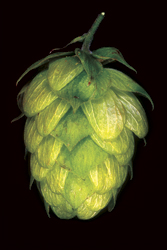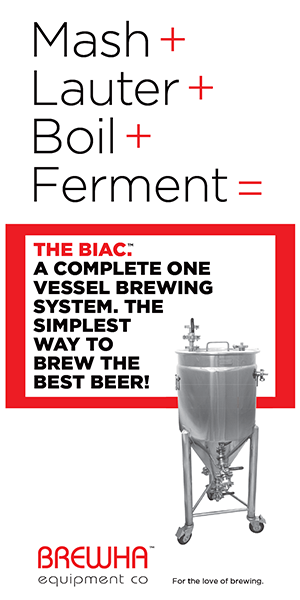Behind the IBU
Bitterness is an important component in beer and is measured in IBUs — International Bitterness Units. The definition of IBUs that most homebrewers are familiar with is one IBU equals 1 milligram (mg) of isomerized alpha acid per liter (L). (Equivalently, one IBU can also be expressed as one part per million (ppm) iso-alpha acids.) In practice, however, measured levels of IBUs in a beer may deviate from this definition.
I recently attended the International Brewers Symposium on Hop Flavor and Aroma at Oregon State University in Corvallis. There, I was able to talk with several of the top hop researchers and brewing scientists in the world. In addition to a lot of molecular structure and organic chemistry that was way over my head, I learned about the history of measuring bitterness in beer. Although this knowledge will not change our brewing practices, it provides insight into the theory and measurement of bitterness in our favorite beverage.
History of measurement
Brewers have been attempting to classify and quantify hop bitterness in beer since the late 1800s. The alpha (humulone-type) and beta acids (lupulone-type) in the lupulin glands were isolated about this time, and by the early 1900s, scientists realized that those particular components were not present in beer — the hop bitterness and aroma components were transformed by the brewing process. During the 1920s, 30s and 40s, the molecular structures of these compounds were investigated to determine how alpha and beta acid bitterness was manifested in beer. In 1939, W. Windisch described the bittering potential of the oxidation products of beta acids, and in 1947, an isomerized form of humulone (one of the alpha acids) was isolated from beer by F. Goveart and M. Verzele. These discoveries lead to efforts to develop a reliable and repeatable test method for measuring bitterness in beer.
In 1953, F.L. Rigby and J.L. Bethune used countercurrent distribution (or CCD) to isolate iso-humulone from beer. Countercurrent distribution uses a series of small glass chambers to sequentially isolate different components in a liquid by using two immiscible solvents. In fact, they were able to use this technique on lupulin in hops and determine that there were actually three main types of both alpha and beta acids: humulone, cohumulone and adhumolone, and lupulone, colupulone and adlupulone. Their method was sound, but it took an entire day to test one sample.
Countercurrent distribution was the forerunner of modern high performance liquid chromatography (HPLC), which was developed in the 1970s. Today, using HPLC, samples can be run quickly, and methods have been developed for accurately measuring alpha and beta acid content in hops. Prior to the ‘70s, though, a straightforward method of estimating IBUs was needed. Even today, however, most IBU measurements are made using this older method because the required equipment is relatively inexpensive.
The standard method
Spectrophotometry involves shining a light through a sample and seeing how much of that light passes through. All dissolved substances absorb light strongly at some wavelengths and weakly at others. If you know that a particular molecule — such as an iso-alpha acid — absorbs strongly at a certain wavelength, you can measure the absorbance of light at that wavelength. The more of the substance in the sample, the more light it will block from passing through the sample.
Two competing methods
Spectrophotometric methods for iso-alpha content, similar to the American Society of Brewing Chemists (ASBC) method adopted in 1950 for determining beer color, were investigated and two competing methods were published in 1955. The first method, by Rigby and Bethune, focused on isolating the iso-alpha content of beer via spectrometry of a multiple-step, solvent-extracted sample. Solvent extraction works on the principal that the organic hop compounds (such as iso-alpha acids) are more soluble in solvent than they are in water. They reported that the method over-reported the iso-alpha by 30% compared to the CCD method for the same beers due to “interfering substances” and that the results for iso-humulone were probably not the best indicator for overall
beer bitterness.
The second method, proposed by the team of A. B. Moltke and M. Meilgaard, in communication with Rigby and Bethune, took a step back and used a simpler solvent extraction method to isolate a menagerie of hop compounds that were chemically similar to iso-alpha. This sample was then measured at a wavelength of 275 nanometers (nm) and the number was compared to iso-alpha measurements of the same beers by CCD.
This data was analyzed to develop a linear regression equation for perceived bitterness as a function of spectrophotometrically measured iso-alpha acid extract (which, remember, includes other compounds as well as). Over the next ten years, the ASBC and the European Brewing Congress (EBC) went back and forth with different variations and equations based on the method, and by 1968 they had both settled on the following equation that is still in use today.
The formula is:
IBU = 50 x Abs@275nm
where Abs@275nm stands for absorbance of the sample at 275 nm. The number 50 is a coefficient, rounded down from 51.2, based on the slope of the correlation and ratio of solvent used.
If the chemistry in the article is a little perplexing to you, here is all you need to know to this point. In the past a fairly accurate measure of iso-alpha acids was developed — the CCD method. However, this method was very time consuming. Later, a “quick and dirty” method — using spectrophotometry and correlated to the CCD method — was developed, and this method is still used today.
Fresh versus aged hops
Now we need to take a step back and look at the beer that was being measured then, versus what is being measured today. For most of the twentieth century, hops were low alpha acid aroma varieties, and they were transported and stored with only moderate refrigeration. In addition, hops were typically anywhere from 6 to 20 months old at the time of use. An aroma hop that has been stored for 18 months at 40 °F (4 °C) will have lost about 50% of its original alpha acid content. Hop beta acids are being oxidized meanwhile, and those oxidation products (called hulupones) are bitter, perhaps as much as iso-alpha, but the quality of the bitterness is different.
Several hop aging studies have been conducted over the years and all have demonstrated the loss of alpha acids to oxidation over time. M. Ono, et. al., (ASBC Journal 45-02, 1987) compared two batches of beer brewed with fresh versus aged European aroma variety hop pellets. The bitterness of the two beers was found to be very different. The fresh-hopped beer measured 22 IBUs (standard method) with 23.5 ppm of iso-alpha as determined by HPLC. The aged-pellet hop beer was made with hops stored for one year at 50 °F (10 °C) in a punctured oxygen-barrier bag. This beer also measured 22 IBUs by the standard method, but HPLC showed that it only had 3.6 ppm of iso-alpha acids.
The flavor of the two beers was evaluated by an experienced five member tasting panel, and found to be quite different. The beer brewed with aged hops “tasted markedly less bitter, exhibited less sharp bitterness, and showed a more strongly oxidized hoppy and less fragrant hoppy aroma” than the fresh-hopped beer. But, the aged hop bitterness was not perceived as being more astringent. All five panelists preferred the fresh hopped beer flavor, however.
That study illustrates two important points. First, that the standard international UV spectroscopy method for IBUs does not measure the actual concentration of iso-alpha acid, it measures the absorption at a specific wavelength of light of a group of compounds that are chemically similar to iso-alpha. Secondly, in the spectrophotometric method, compounds other than iso-alpha acids contribute to the measured IBU number — and this can yield similar IBU values in beers brewed with fresh or aged hops, despite differences in perceived bitterness. The other compounds that contribute to IBU in the spectrophotometric method include bitter oxidized beta acids, decomposition products of alpha and beta acids (which are not bitter) and some hop polyphenols (which are thought to be bitter), like xanthohumol.
Homebrews and IBUs
So what does this mean, practically, to homebrewers? Do we need to change the way we formulate our recipes? The results of the Ono study really tell us all we need to know. When fresh hops are used, the HPLC, spectrophotometric method and tasting panel were all basically in agreement. When aged hops were used, the HPLC and tasting panel indicated that the beer was less bitter, but the spectrophotometric method returned a level of bitterness similar to that of the fresh-hopped beer. However, unless you are brewing with aged hops and measuring your IBUs using the standard method, this shouldn’t affect your brewday practices.
When we calculate IBUs with our brewing software, we input the amount of alpha acid that is going into the kettle, as well as the boil time and wort gravity. The software then outputs a number that is an estimation of the concentration of retained iso-alpha acids in the beer. If we use fresh hops — and have estimated our hop utilization accurately — our calculated IBU values should be tolerably close to IBUs as measured by either lab method (although this would need to be confirmed with lab testing). Keep in mind, though, that overall utilization involves more than isomerization of alpha acids in the kettle. Alpha and iso-alpha losses are known to occur throughout the brewing process, for example by being carried out of solution by adhering to break material, trub, yeast and vessel walls.
A complete model of beer bitterness would include not only iso-alpha acids, but other bitter compounds found in hops (fresh or aged) and beer. Likewise, a 100% percent reliable method of measurement would not be influenced by non-bitter substances. However, the “simple” method of IBU calculation based on the alpha acid content of our hops, boil time and wort gravity works well in practice and should yield a value in the ballpark of the IBU value that would be measured by the spectrophotometric method. We don’t need to develop a perfect model. We simply need to understand the basis of an IBU, and what it means as a target for our raw materials. We can then apply our skill and art as brewers to craft a good beer.
The majority of the material for this article comes from the paper, “The International Bitterness Unit (IBU), its Creation and what it Measures,” by V. Peacock, Proceedings of the First International Symposium on Hop Flavor and Aroma, 2007 (in press). The author would like to thank Val Peacock of Anheuser-Busch, Tom Neilsen of Sierra Nevada, and Brad Sturgeon of Monmouth College for their help in understanding this material.




